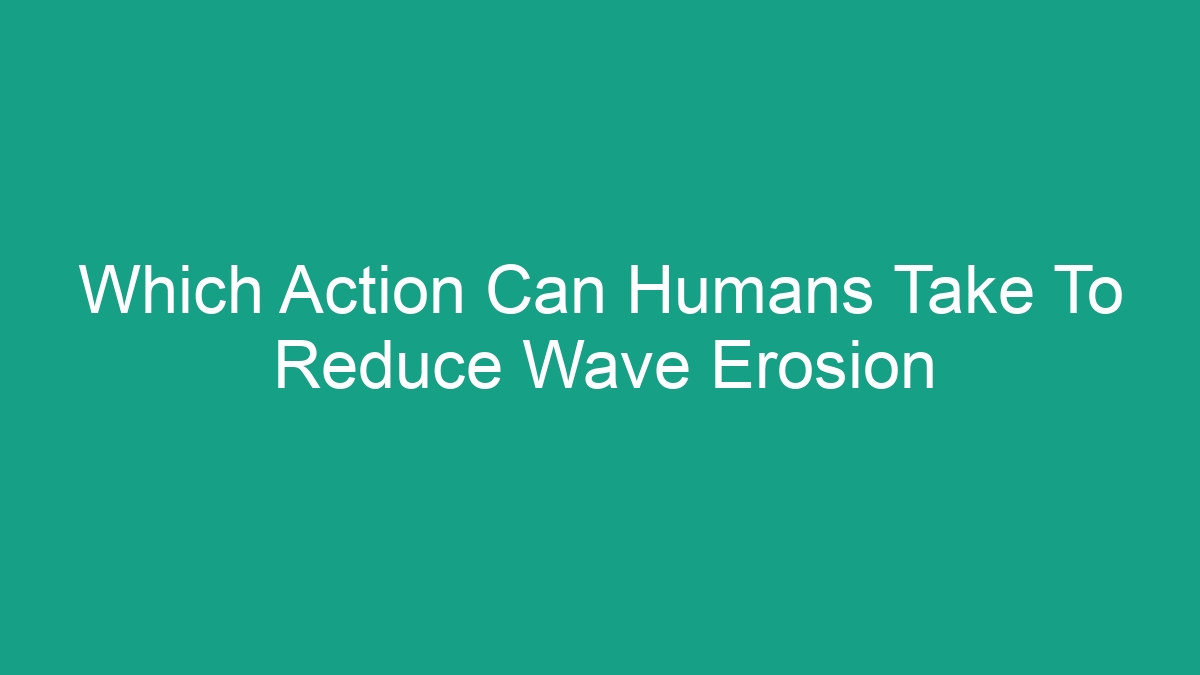
Introduction to Wave Erosion
Wave erosion is a natural process that occurs when waves hit the shoreline and remove sediment and rocks. This process can result in the loss of land and damage to coastal infrastructure. In areas where wave erosion is particularly severe, human intervention is often necessary to protect the coastline and prevent further damage. There are several actions that humans can take to reduce wave erosion and mitigate its effects.
Understanding the Causes of Wave Erosion
Before discussing potential solutions to wave erosion, it’s important to understand the factors that contribute to this process. Wave erosion can be caused by a combination of natural forces such as wave energy, tidal patterns, and storm surges, as well as human activities like construction and development along the coastline. These factors can exacerbate wave erosion and make the coastline more vulnerable to damage.
Actions to Reduce Wave Erosion
There are several actions that humans can take to reduce wave erosion and protect the coastline. These actions can range from natural, non-structural approaches to engineered solutions that involve the construction of coastal defenses.
1. Beach Nourishment
Beach nourishment involves adding sand or sediment to beaches to replenish eroded shorelines. This can help absorb wave energy and reduce the impact of waves on the coastline. Beach nourishment projects are often carried out using dredged sand from offshore sources or from nearby quarries. This approach is cost-effective and can provide immediate relief from wave erosion.
2. Dune Restoration
Dune restoration involves the planting of native vegetation on sand dunes to stabilize them and protect the shoreline from wave erosion. Dunes act as natural barriers against wave energy and can help absorb and dissipate the impact of waves, reducing erosion along the coastline. Restoring and maintaining healthy dune systems is a crucial aspect of coastal protection.
3. Seawalls and Breakwaters
Seawalls and breakwaters are engineered structures built along the shoreline to protect coastal areas from the force of waves. Seawalls are vertical structures designed to deflect wave energy and prevent erosion, while breakwaters are offshore barriers that help reduce the intensity of waves before they reach the shore. These structures provide effective protection against wave erosion but can be costly to construct and maintain.
Best Practices for Coastal Management
When it comes to reducing wave erosion, it’s important for coastal management to take a holistic approach that considers the unique characteristics of each coastline. The following best practices can help guide effective coastal management efforts:
- Conducting thorough coastal assessments to understand the specific erosion risks and vulnerabilities of a given coastline.
- Engaging with local communities and stakeholders to develop sustainable coastal management plans that prioritize the protection of natural habitats and ecosystems.
- Using a combination of natural and engineered solutions to address wave erosion, taking into account the long-term effectiveness and environmental impact of each approach.
- Implementing monitoring and maintenance programs to regularly assess the condition of coastal defenses and make any necessary repairs or improvements.
FAQs about Wave Erosion
What are the environmental impacts of wave erosion?
Wave erosion can lead to the loss of coastal habitats, including wetlands, beaches, and dunes. This can have a detrimental impact on local ecosystems and wildlife. Additionally, wave erosion can contribute to coastal flooding and the destruction of coastal infrastructure, leading to economic and social disruptions.
Is it possible to completely stop wave erosion?
While it may not be possible to completely eliminate wave erosion, effective coastal management practices can help reduce its impact and protect vulnerable coastlines. By implementing a combination of natural and engineered solutions, it is possible to mitigate the effects of wave erosion and safeguard coastal areas.
How can individuals contribute to reducing wave erosion?
Individuals can contribute to reducing wave erosion by being mindful of their impact on the coastal environment. This includes avoiding activities that disturb dune systems and vegetation, supporting beach nourishment and restoration efforts, and participating in coastal cleanup initiatives to protect marine ecosystems.
In conclusion, wave erosion poses a significant threat to coastal areas around the world, but there are actions that humans can take to reduce its impact. By implementing a combination of natural and engineered solutions, and following best practices for coastal management, it is possible to mitigate the effects of wave erosion and protect vulnerable coastlines for future generations.



